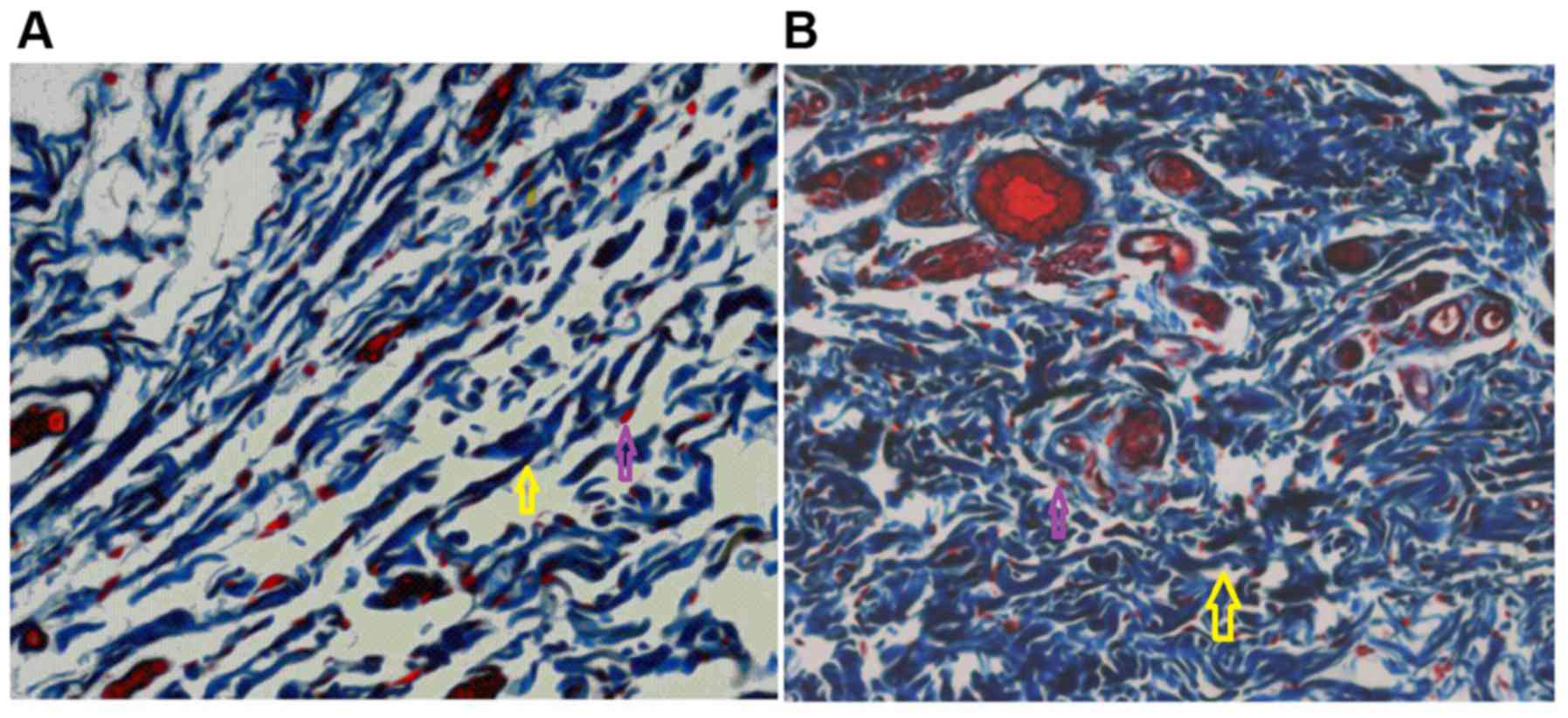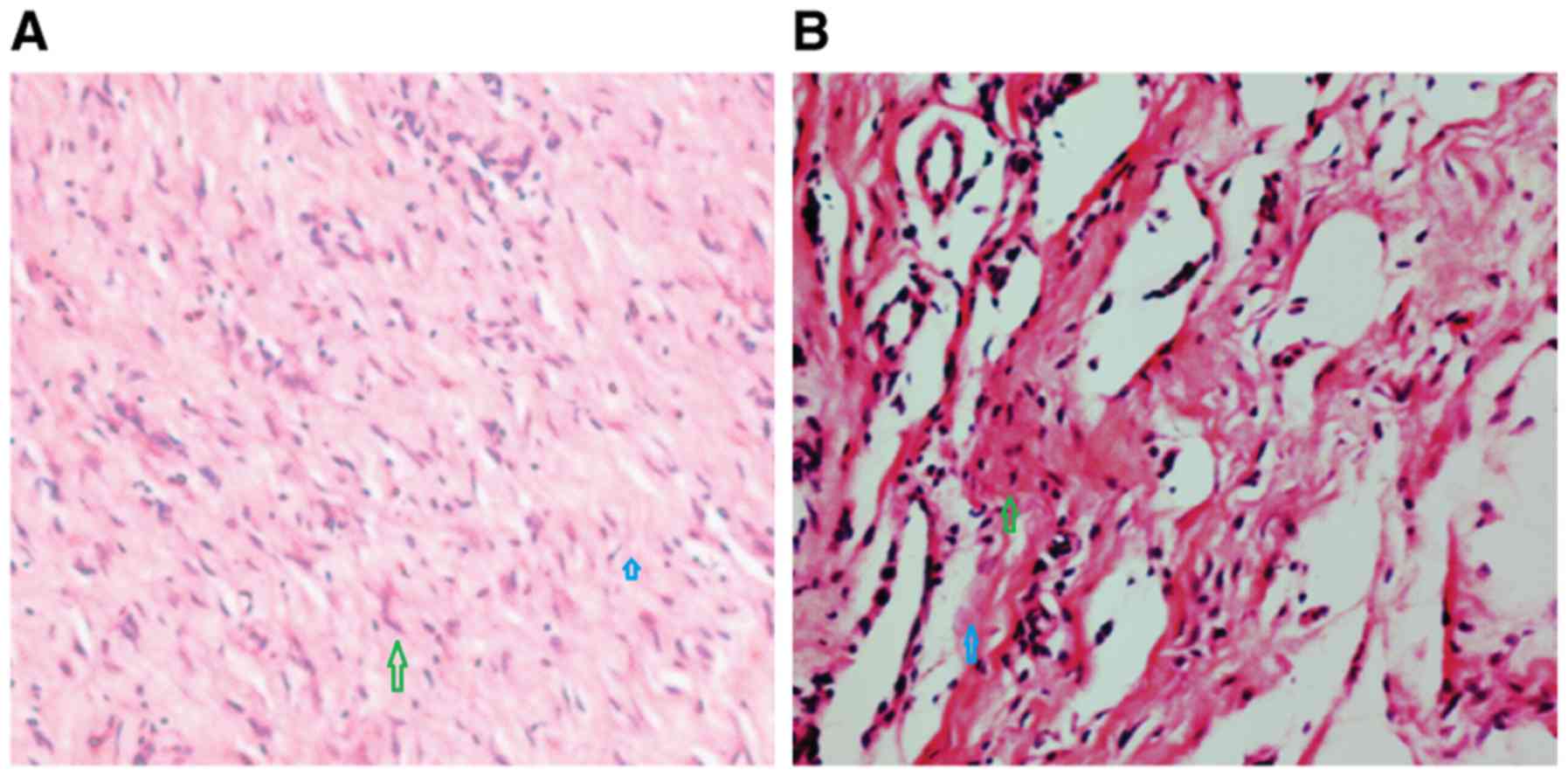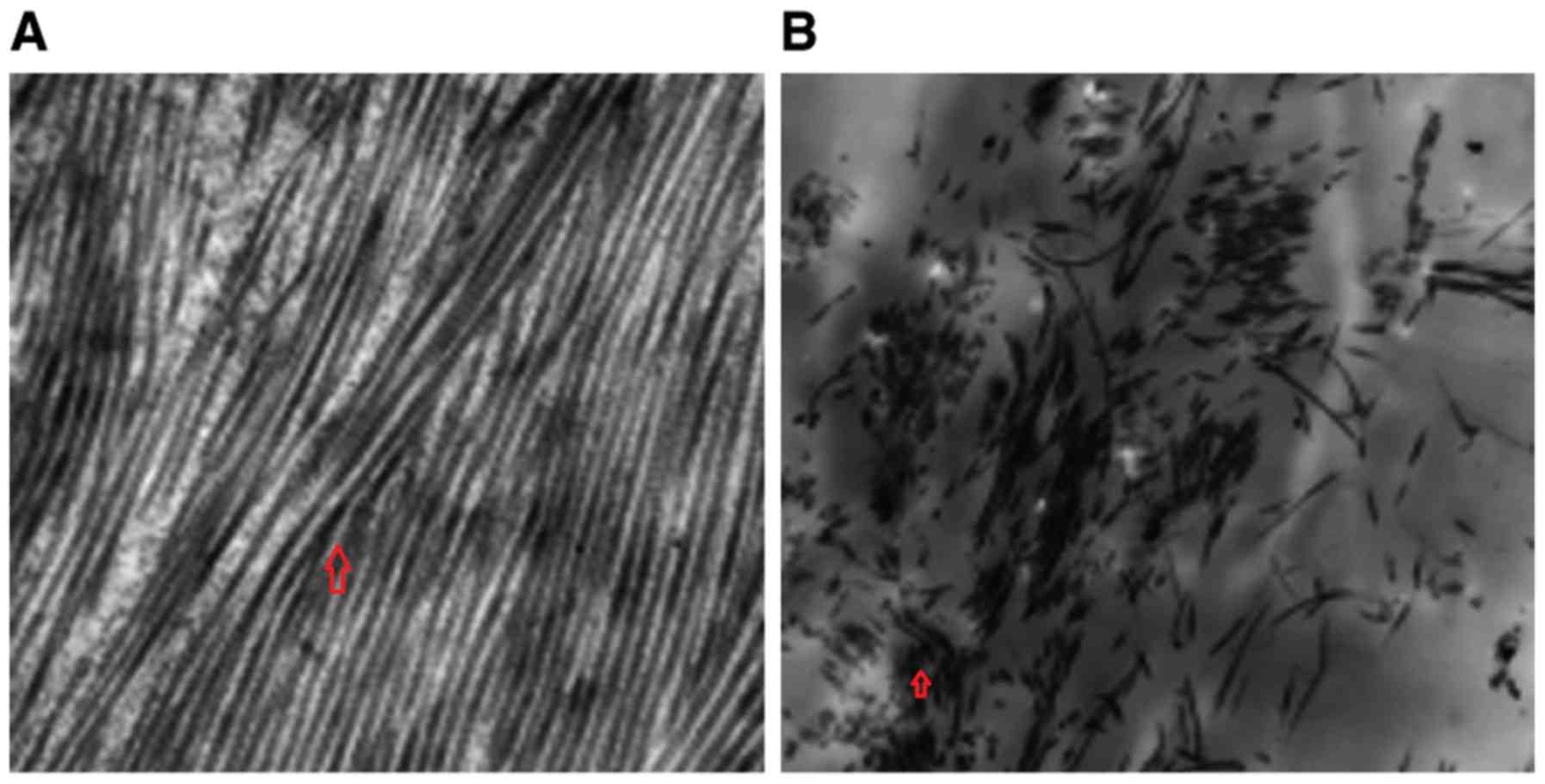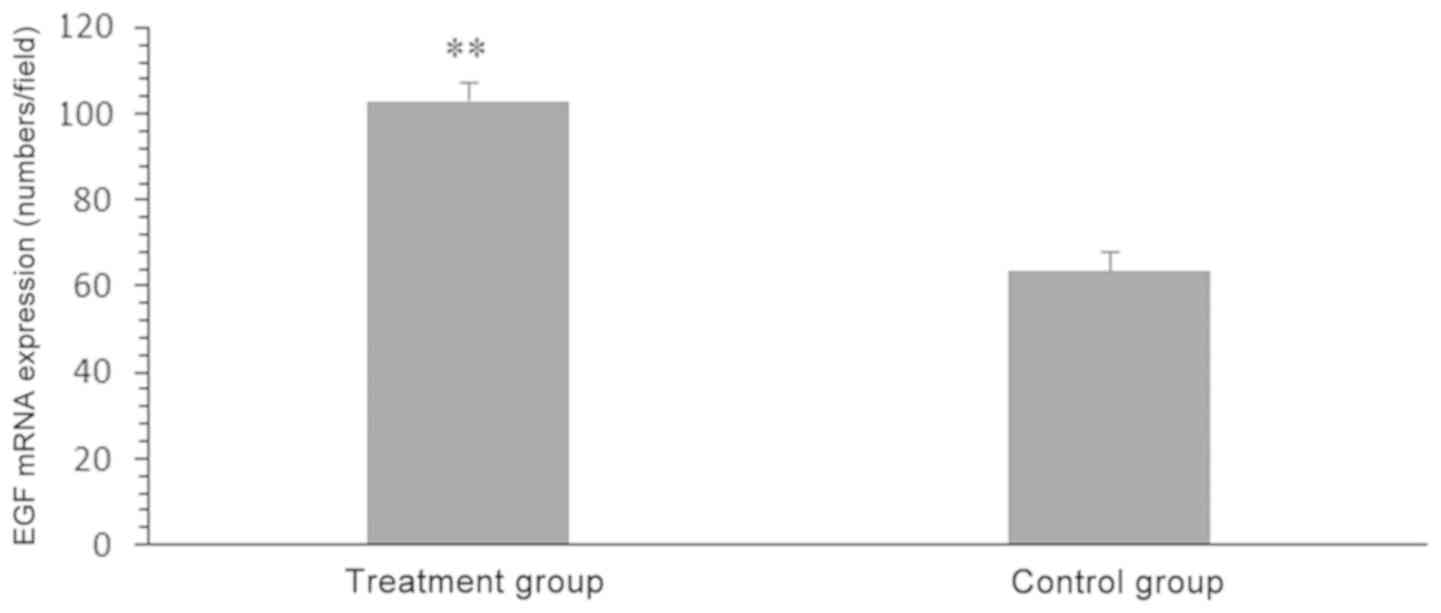|
1
|
Iraj B, Khorvash F, Ebneshahidi A and
Askari G: Prevention of diabetic foot ulcer (DFU). Int J Prev Med.
4:373–376. 2013.PubMed/NCBI
|
|
2
|
Wojciechowski VV, Calina D, Tsarouhas K,
Pivnik AV, Sergievich AA, Kodintsev VV, Filatova EA, Ozcagli E,
Docea AO, Arsene AL, et al: A guide to acquired vitamin K
coagulophathy diagnosis and treatment: The Russian perspective.
Daru. 25:102017. View Article : Google Scholar : PubMed/NCBI
|
|
3
|
Asadi M, Alamdari DH, Rahimi HR,
Aliakbarian M, Jangjoo A, Abdollahi A, Bahar MM, Azadmand A,
Forghani N, Sadegh MN, et al: Treatment of life threatening wounds
with a combination of allogenic platelet rich plasma, fibrin glue
and collagen matrix, and a literature review. Exp Ther Med.
8:423–429. 2014. View Article : Google Scholar : PubMed/NCBI
|
|
4
|
Călina D, Docea AO, Roşu L, Zlatian O,
Roşu AF, Anghelina F, Rogoveanu O, Arsene AL, Nicolae AC, Drăgoi
CM, et al: Antimicrobial resistance development following surgical
site infections. Mol Med Rep. 15:681–688. 2017. View Article : Google Scholar : PubMed/NCBI
|
|
5
|
Tănase A, Colita A, Ianosi G, Neagoe D,
Branisteanu DE, Calina D, Docea AO, Tsatsakis A and Ianosi SL: Rare
case of disseminated fusariosis in a young patient with graft vs.
host disease following an allogeneic transplant. Exp Ther Med.
12:2078–2082. 2016. View Article : Google Scholar : PubMed/NCBI
|
|
6
|
Blumberg SN, Berger A, Hwang L, Pastar I,
Warren SM and Chen W: The role of stem cells in the treatment of
diabetic foot ulcers. Diabetes Res Clin Pract. 96:1–9. 2012.
View Article : Google Scholar : PubMed/NCBI
|
|
7
|
Mcardle C, Lagan K, Spence S and McDowell
D: Diabetic foot ulcer wound fluid: The effects of pH on DFU
bacteria and infection. J Foot Ankle Res. 8 Suppl 1:A82015.
View Article : Google Scholar
|
|
8
|
Buchberger B, Follmann M, Huppertz H and
Wasem J: Health technology assessment (HTA) on the importance of
growth factors for the treatment of diabetic foot ulcers (DFU). Das
Gesundheitswesen. 72:491–501. 2010. View Article : Google Scholar
|
|
9
|
Sheehan P, Jones P, Caselli A, Giurini JM
and Veves A: Percent change in wound area ofdiabetic foot ulcers
over a 4-week period is a robust predictor of complete healing in a
12-week prospective trial. Diabetes Care. 26:1879–1882. 2003.
View Article : Google Scholar : PubMed/NCBI
|
|
10
|
Gilligan AM, Waycaster CR and Landsman AL:
Wound closure in patients with DFU: A cost-effectiveness analysis
of two cellular/tissue-derived products. J Wound Care. 24:149–156.
2015. View Article : Google Scholar : PubMed/NCBI
|
|
11
|
Singh K, Singh VK, Agrawal NK, Gupta SK
and Singh K: Association of toll-like receptor 4 polymorphisms with
diabetic foot ulcers and application of artificial neural network
in DFU risk assessment in type 2 diabetes patients. Biomed Res Int.
2013:3186862013. View Article : Google Scholar : PubMed/NCBI
|
|
12
|
Mcdonnell J, Redekop K, Verboom P, Lovas K
and Kalo Z: PDG15: The cost of treating diabetic foot ulcers (dfu)
with apligraf in the Netherlands. Value Health. 4:5082001.
View Article : Google Scholar
|
|
13
|
Hong JP, Jung HD and Kim YW: Recombinant
human epidermal growth factor (EGF) to enhance healing for diabetic
foot ulcers. Ann Plast Surg. 56:394–398; discussion 399–400. 2006.
View Article : Google Scholar : PubMed/NCBI
|
|
14
|
Robson MC: Invited discussion: Recombinant
human epidermal growth factor (EGF) to enhance healing for diabetic
foot ulcers. Ann Plast Surg. 56:399–400. 2006. View Article : Google Scholar
|
|
15
|
Choi JS, Leong KW and Yoo HS: In vivo
wound healing of diabetic ulcers using electrospun nanofibers
immobilized with human epidermal growth factor (EGF). Biomaterials.
29:587–596. 2008. View Article : Google Scholar : PubMed/NCBI
|
|
16
|
Mohan VK: Recombinant human epidermal
growth factor (REGEN-D 150): Effect on healing of diabetic foot
ulcers. Diabetes Res Clin Pract. 78:405–411. 2007. View Article : Google Scholar : PubMed/NCBI
|
|
17
|
Aktaş Ş, Baktıroğlu S, Demir L, Kılıçoğlu
Ö, Topalan M, Güven E, Mirasoğlu B and Yanar F: Intralesional
application of epidermal growth factor in limb-threatening ischemic
diabetic foot ulcers. Acta Orthop Traumatol Turc. 50:277–283.
2016.PubMed/NCBI
|
|
18
|
Dumantepe M, Fazliogullari O, Seren M,
Uyar I and Basar F: Efficacy of intralesional recombinant human
epidermal growth factor in chronic diabetic foot ulcers. Growth
Factors. 33:128–132. 2015. View Article : Google Scholar : PubMed/NCBI
|
|
19
|
Chen F, Lin L, Zhang HJ, Ye XX, Zhao WZ,
Wang T and Yang XN: Roles of hepatocyte growth factor, c-Met and
epidermal growth factor receptor in repair of colonic mucosa from
patients with ulcerative colitis. Shiji Hua Ren Xiao Hua Za Zhi.
14:594–599. 2006.(In Chinese).
|
|
20
|
Chen F, Lin L, Zhang HJ and Wang T: Effect
of epidermal growth factor receptor in the repair of colonic mucosa
in patients with ulcerative colitis. Zhongguo Lin Chuang Kang Fu Za
Zhi. 9:104–106. 2005.(In Chinese).
|
|
21
|
Sun L, Kwok E, Gopaluni B and Vahidi O:
Pharmacokinetic-pharmacodynamic modeling of metformin for the
treatment of type II diabetes mellitus. Open Biomed Eng J. 5:1–7.
2011. View Article : Google Scholar : PubMed/NCBI
|
|
22
|
Hu YH, Yun SF, Zhou SM and Tian XY:
Influence of Sumianxin Anesthesia on Physiology in Rabbits.
Zhongguo Bi Jiao Yi Xue Za Zhi. 16:475–478. 2006.(In Chinese).
|
|
23
|
Cao CY, Kang N, Yan L, Hu ZY, Shen ZH and
Wang Q: Anesthetic effect of sumianxin II combined with chloral
hydrate on rabbit. Zhongguo Bi Jiao Yi Xue Za Zhi. 24:25–18.
2014.(In Chinese).
|
|
24
|
Huang J: Scientific breeding management of
experimental rabbits. Animal Husbandry Veterinarian of Zhejiang.
3:471995.
|
|
25
|
Li X, Liu W, Kou H, Zhou W, Li T, Dong B
and Liang P: Experimental study of image-guided percutaneous
microwave ablation in rabbit lung VX2 tumor model. Int J Clin Exp
Pathol. 7:905–913. 2014.PubMed/NCBI
|
|
26
|
Yuan ZW, Pei LY, Qiu JL, et al: Anesthesia
of commonly used experimental animals. Chinese J Comparative
Medicine. 14:245–247. 2004.(In Chinese).
|
|
27
|
Pixin R and Shengfu D: Effects of
epidermal growth factor (EGF) on circumflex function of isolated
pulmonary artery in rats. Chinese J Pathophysiol. 2:173–176.
1994.(In Chinese).
|
|
28
|
Liu Y, Pei G and Jiang S: New porous
beta-tricalcium phosphate as scaffold for bone tissue engineering.
Zhongguo Xiu Fu Chong Jian Wai Ke Za Zhi. 21:1123–1127. 2007.(In
Chinese). PubMed/NCBI
|
|
29
|
Ertugrul BM, Buke C, Ersoy OS, Ay B,
Demirez DS and Savk O: Intralesional epidermal growth factor for
diabetic foot wounds: The first cases in Turkey. Diabetic Foot
Ankle. 6:284192015. View Article : Google Scholar : PubMed/NCBI
|
|
30
|
Fan HJ, Yu JH, Cui GM, Zhang WY, Yang X
and Dong QJ: Insulin pump for the treatment of diabetes in
combination with ulcerative foot infections. J Biol Regul Homeost
Agents. 30:465–470. 2016.PubMed/NCBI
|
|
31
|
Thomson SE, McLennan SV and Twigg SM:
Growth factors in diabetic complications. Expet Rev Clin Immunol.
2:403–418. 2006. View Article : Google Scholar
|
|
32
|
Han HM, Guo L, Jiang LJ, Jiang XY, Lv YL,
Pang JK, Bai ZM, Che WJ, Xu RH, Yu P and Li Q: A microarray study
on the molecular mechanism for the therapeutic effect of Antidotal
and Myogenic Ointment on the foot ulcer in diabetic rats. Zhongguo
Wei Zhong Bing Ji Jiu Yi Xue. 23:621–624. 2011.(In Chinese).
PubMed/NCBI
|
|
33
|
Wan Y, Yang YJ, Li YS, Li XJ, Zhang W, Liu
M and Tang HB: Effects of San-huang-sheng-fu oil on peripheral
circulatory disorders and foot ulcers in diabetic rats and the
mechanisms. Zhonghua Shao Shang Za Zhi. 32:168–175. 2016.(In
Chinese). PubMed/NCBI
|
|
34
|
Demidova-Rice TN, Hamblin MR and Herman
IM: Acute and impaired wound healing: Pathophysiology and current
methods for drug delivery, part 2: Role of growth factors in normal
and pathological wound healing: Therapeutic potential and methods
of delivery. Adv Skin Wound Care. 25:349–370. 2012. View Article : Google Scholar : PubMed/NCBI
|
|
35
|
Jennings JA, Crews RM, Robinson J,
Richelsoph K, Cole JA, Bumgardner JD, Yang Y and Haggard WO: Effect
of growth factors in combination with injectable silicone resin
particles on the biological activity of dermal fibroblasts: A
preliminary in vitro, study. J Biomed Mater Res B Appl Biomater.
92:255–260. 2010. View Article : Google Scholar : PubMed/NCBI
|
|
36
|
Yuan N, Wang C, Wang Y, Yu T, Long Y,
Zhang X and Ran X: Preparation of autologous platelet-rich gel for
diabetic refractory dermal ulcer and growth factors analysis from
it. Zhongguo Xiu Fu Chong Jian Wai Ke Za Zhi. 22:468–471. 2008.(In
Chinese). PubMed/NCBI
|
|
37
|
Zhou LS, Liao ZJ, Zhang Q, Luo M, Lu G and
Zhang W: Bio-inductive effects of inorganic elements on skin wound
healing. Zhonghua Shao Shang Za Zhi. 21:363–366. 2005.(In Chinese).
PubMed/NCBI
|
|
38
|
Jiang XH, Zhou WM, He YZ, Wang Y, Lv B and
Wang XM: Effects of lipopeptide carboxymethyl chitosan
nanoparticles on Staphylococcus aureus biofilm. J Biol Regul
Homeost Agents. 31:737–743. 2017.PubMed/NCBI
|
|
39
|
Buteică AS, Mihăescu DE, Grumezescu AM,
Vasile BS, Popescu A, Călina D and Mihăiescu OM: The citotoxicity
of (non)magnetic nanoparticles tested on Escherichia coli
and Staphylococcus aureus. Dig J Nanomater Biostruct.
5:651–655. 2010.
|
|
40
|
Acosta JB, Savigne W, Valdez C, Franco N,
Alba JS, del Rio A, López-Saura P, Guillén G, Lopez E, Herrera L
and Férnandez-Montequín J: Epidermal growth factor intralesional
infiltrations can prevent amputation in patients with advanced
diabetic foot wounds. Int Wound J. 3:232–239. 2006. View Article : Google Scholar : PubMed/NCBI
|
|
41
|
Galkowska H, Wojewodzka U and Olszewski
WL: Chemokines, cytokines, and growth factors in keratinocytes and
dermal endothelial cells in the margin of chronic diabetic foot
ulcers. Wound Repair Regen. 14:558–565. 2006. View Article : Google Scholar : PubMed/NCBI
|
|
42
|
Pedro A, López Saura, Jorge Berlanga
Acosta, José I, Fernández Montequín, Carmen Valenzuelá Silva,
Odalys González Díaz, William Savigne, Lourdes Morejoń Vega,
Amauryś del Río Martín, Luis Herrera Martínez, et al:
Intralesional human recombinant epidermal growth factor for the
treatment of advanced diabetic foot ulcer: From proof of concept to
confirmation of the efficacy and safety of the procedure. Zhur.
Eksptl'. i Teoret. Fiz. 21:406–409. 2011.
|
|
43
|
Bennett SP, Griffiths GD, Schor AM, Leese
GP and Schor SL: Growth factors in the treatment of diabetic foot
ulcers. Br J Surg. 90:133–146. 2003. View
Article : Google Scholar : PubMed/NCBI
|
|
44
|
Margolis DJ, Bartus C, Hoffstad O, Malay S
and Berlin JA: Effectiveness of recombinant human platelet-derived
growth factor for the treatment of diabetic neuropathic foot
ulcers. Wound Repair Regen. 13:531–536. 2005. View Article : Google Scholar : PubMed/NCBI
|
|
45
|
Buchberger B, Follmann M, Freyer D,
Huppertz H, Ehm A and Wasem J: The evidence for the use of growth
factors and active skin substitutes for the treatment of
non-infected diabetic foot ulcers (DFU): A health technology
assessment (HTA). Exp Clin Endocrinol Diabetes. 119:472–479. 2011.
View Article : Google Scholar : PubMed/NCBI
|
|
46
|
Galstyan GR, Ignatieva VI, Avksentieva MV
and Dedov II: Pharmacoeconomic analysis of epidermal growth factor
(HeberprotP®) for the treatment of diabetic foot ulcers.
Endocrine Surgery. 7:4–15. 2013. View Article : Google Scholar
|
|
47
|
Tuyet HL, Nguyen Quynh TT, Vo Hoang Minh
H, Thi Bich DN, Do Dinh T, Le Tan D, Van HL, Le Huy T, Doan Huu H
and Tran Trong TN: The efficacy and safety of epidermal growth
factor in treatment of diabetic foot ulcers: The preliminary
results. Int Wound J. 6:159–166. 2009. View Article : Google Scholar : PubMed/NCBI
|
|
48
|
Tiaka EK, Papanas N, Manolakis AC and
Georgiadis GS: Epidermal growth factor in the treatment of diabetic
foot ulcers: An update. Perspect Vasc Surg Endovasc Ther. 24:37–44.
2012. View Article : Google Scholar : PubMed/NCBI
|
|
49
|
Afshari M, Larijani B, Fadayee M, Farzaneh
Darvishzadeh, Ghahary A, Pajouhi M, Bastanhagh MH, Baradar-Jalili R
and Vassigh AR: Efficacy of topical epidermal growth factor in
healing diabetic foot ulcers. Therapy. 2:759–765. 2016. View Article : Google Scholar
|
|
50
|
Lihuan D: Regenerated cellulose skin
repair materials: preparation and performance. Zhongguo Zu Zhi Gong
Cheng Yan Jiu. 19:6098–6103. 2015.(In Chinese).
|
|
51
|
Singla S, Singla S, Kumar A and Singla M:
Role of epidermal growth factor in healing of diabetic foot ulcers.
Indian J Surg. 74:451–455. 2012. View Article : Google Scholar : PubMed/NCBI
|
|
52
|
Gałkowska H and Olszewski W: Cellular and
molecular basis of impaired healing of diabetic foot ulcers. Polish
J Surg. 79:720–727. 2007. View Article : Google Scholar
|
|
53
|
Li Q, Wang Y and Yang L: Curative effect
observation of recombinant human epidermal growth factor in
treatment of oral ulcer in children with hand-foot-mouth disease.
Erke Yao Xue Za Zhi. 23:533–547. 2015.(In Chinese).
|


















